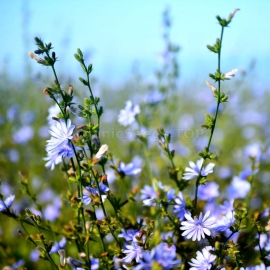





«Caesarr» - Organic Chicory Seeds
1.14 €
Chicory has been in cultivation since the days of ancient Egypt. The oldest publication about herbs in existence, authored by Greek physician Dioscorides, includes information about chicory. President Thomas Jefferson planted chicory in his garden.
-
Organic Chicory «Caesarr»
Chicory has been in cultivation since the days of ancient Egypt. The oldest publication about herbs in existence, authored by Greek physician Dioscorides, includes information about chicory.
Horticulture enthusiast and president Thomas Jefferson planted chicory in his gardens, recommending it in a letter to his friend George Washington as “one of the greatest acquisitions a farmer can have.” Chicory’s most well known culinary use is the use of the root as a coffee substitute or additive, since it has a soothing and relaxing effect that balances out the stimulation of coffee.
Fresh leaves of specialty varieties of chicory such as radicchio and endive make wonderful salad greens, and even the leaves of wild chicory make an acceptable substitute for spinach. As a wildflower, this plant springs up everywhere with its bright blue dandelion-like flowers that open and close with the sun.
Chicory Germination
Direct sow in early spring, planting the seed 1/4” deep in loose soil; keep the soil lightly moist until germination, which should occur in 10-14 days. This plant grows best in rich soil, but also adapts well to poor soil.
Growing Chicory Seeds
As the seedlings develop, make sure to remove all weeds and keep the soil consistently moist. Mature plants tolerate drought well. We cannot sell this seed to customers in CO or SD.
Harvesting Chicory
Cut young, tender leaves for fresh greens; do not freeze or dry them, since this deprives them of all flavor. They can be stored in the refrigerator for several days. The root can be harvested any time after four months of growth, but before the ground freezes.
Saving Chicory Seeds
Allow the flowers to dry on the plant and develop into seed heads; the mature seed in the heads will be hard and brown. Remove the heads and spread them out for several days to dry completely. Crush the seed heads to remove the seed, and separate the seed from the chaff. Store the seed in a cool, dry place.
Uses
The leaves are edible but rather bitter, especially when the plants are flowering. The leaves are often blanched by excluding light, either by removing all the leaves and then earthing up the new growth, or by covering the plant with a bucket or something similar. Whilst this greatly reduces any bitterness, there is also a corresponding loss of vitamins and minerals. The blanched leaves are often used in winter salads (they are known as chicons) and are also cooked. The unblanched leaves are much less bitter in winter and make an excellent addition to salads at this time of year.
The root can be cooked like parsnip. The boiled young roots form a very palatable vegetable. The root is said to be an ideal food for diabetics because of its inulin content. Inulin is a starch that cannot be digested by humans, it tends to pass straight through the digestive system and is therefore unlikely to be of use to a diabetic.
However, the inulin can be used to make a sweetener that is suitable for diabetics to use. Chicory-root is free of harmful ingredients, and is essentially a concentrated combination of three sugars (pentose, levulose and dextrose) along with taraxarcine (the bitter principle of dandelion). It is especially important as source of levulose. Roots are used in seasoning soups, sauces and gravies, and to impart a rich deep colour.
Edible uses: The leaves are rather bitter, especially when the plants are flowering. The leaves are often blanched by excluding light, either by removing all the leaves and then earthing up the new growth, or by covering the plant with a bucket or something similar. Whilst this greatly reduces any bitterness, there is also a corresponding loss of vitamins and minerals.
The blanched leaves are often used in winter salads (they are known as chicons) and are also cooked. The unblanched leaves are much less bitter in winter and make an excellent addition to salads at this time of year. A nutritional analysis of the leaves is available. Flowers - raw. An attractive addition to the salad bowl, but rather bitter. Root - cooked like parsnip. The boiled young roots form a very palatable vegetable.
When flowering, chicory has a tough, grooved, and more or less hairy stem, from 30 to 100 centimetres (10 to 40 in) tall.The leaves are stalked, lanceolate and unlobed.The flower heads are 2 to 4 centimetres (0.79 to 1.6 in) wide, and bright blue. There are two rows of involucral bracts - the inner are longer and erect, the outer are shorter and spreading. It flowers from July until October.The achenes have no pappus (feathery hairs), but do have toothed scales on top.
